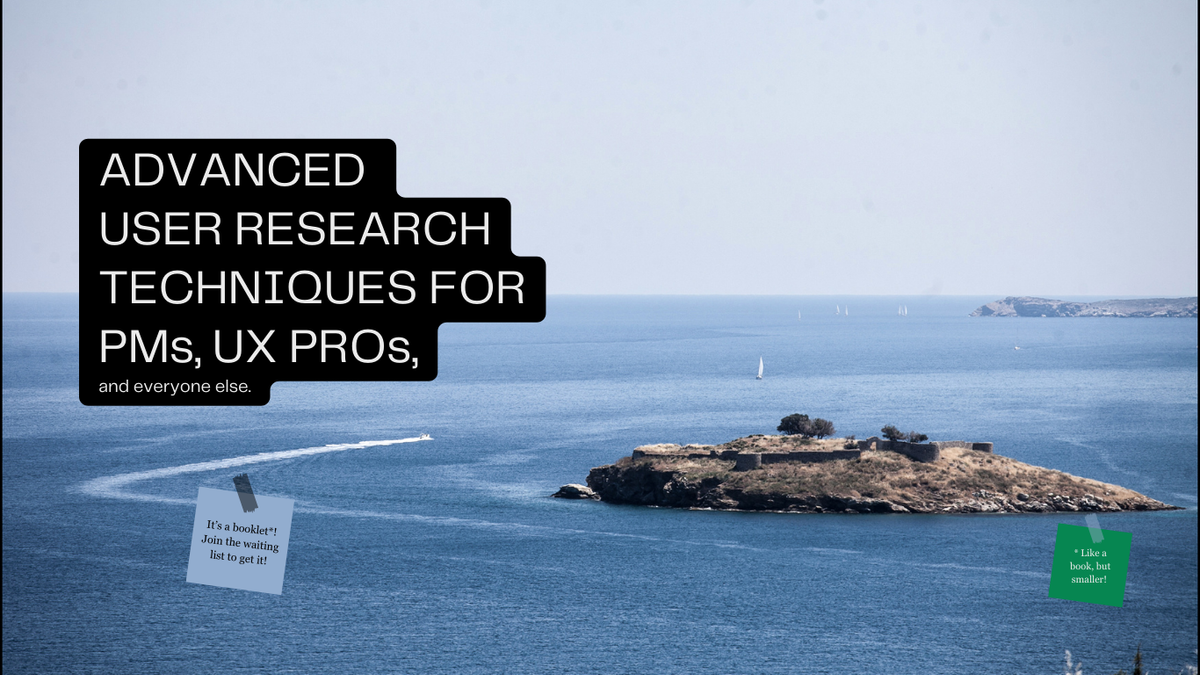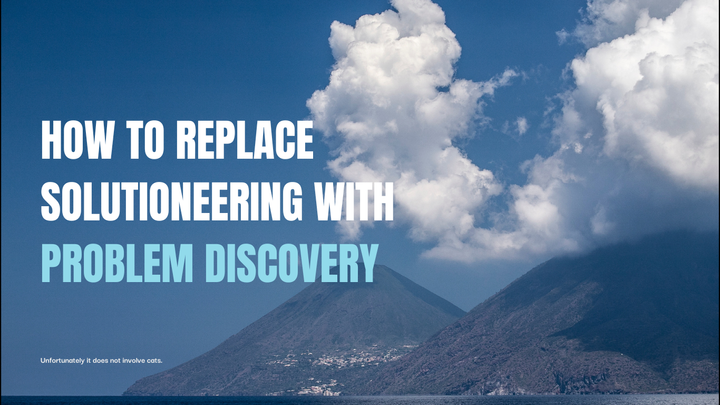Advanced User Research Techniques for PMs
This booklet is designed for Product Managers, UX Professionals and anyone who is eager to deepen their UX research capabilities. Learn how to conduct effective usability studies, user interviews, create detailed service blueprints, and map customer journeys.

I decided to write a booklet after realizing that even with my Master Training in UX Research from Nielsen Norman Group, it is difficult to find organized and specific UX research resources. This led me to think about how many other Product Managers might be looking to excel in their UX research skills, driven either by their current work demands or simply by their own thirst for knowledge or curiosity (which is always a great motivator).
Here's a cute PDF with the same content as this blog post, but nicer looking 😼. It’s a PDF Version of the Booklet's presentation. Not the Booklet itself. Join my waiting mailing list to get the booklet.
Disclaimer:
Please note that the information provided here serves as a presentation overview of the booklet I have authored, rather than the complete content itself. This overview is intended to give you a clear understanding of what to expect from the booklet and to determine if the material aligns with your needs and interests. The actual content of the booklet contains detailed explanations, step-by-step guides, and practical applications that are not fully encapsulated in this brief presentation.
The internet is overflowing with resources. We’ve never had such access to data, yet there’s so little true knowledge. When everyone thinks they know everything, it turns out we know very little. Let’s address this.
I emphasize the “think they know” aspect due to the Dunning-Kruger Effect. The Dunning-Kruger effect is a cognitive bias where people with limited knowledge or competence in a domain overestimate their abilities. In the context of UX Research, this can lead us (yes, all of us, including myself) to believe we understand and know everything there is to know, causing us to stop investigating, learning, and challenging ourselves. This overconfidence can result in significant errors and oversights in gathering and interpreting user data.
As such, this booklet is for open-minded PMs, UX Designers, and anyone who wants to challenge their knowledge and beliefs. Here, you’ll find a collection of verified, spot-on UX research techniques.
This booklet is divided into two parts, with 5 chapters.
Part I presents methods that are commonly used in companies:
- Usability Studies (Moderated & Unmoderated) and
- User Interviews. But these are not the basic, run-of-the-mill approaches you find all over the internet.
What I’m sharing is a more advanced way to conduct these studies, the “right way,” which will definitely positively impact how you approach UX—even if you’re pressed for time. It will help you gain the right insights more quickly, enabling you to advance your Product Roadmap with great confidence.
Part II, I believe, is simply fun. I always enjoy it, as it feels so intuitive—almost self-made, but with a twist.
You’re probably familiar with Workshoping, Service Blueprinting, and Customer Journey Mapping, but these terms have become buzzwords that often lose their meaning. I’ll provide know-how on these topics in a way that brings real value. So, we’ll step into the Service Design realm but with a Product Management twist.
As a PM or UX/UI professional, you already understand how crucial it is to map everything that you do—it helps immensely to know how things work, how they connect, and where the issues lie. If you’re already practicing this on a daily basis, these exercises will feel like a breeze, especially since they are team-based. All you need to do is host workshops and get your entire team involved.
Here's what the booklet contains so you know if it's something you might want to purchase.
Introduction
In this introductory chapter, I’ve outlined a few steps you must take when considering UX. This is your roadmap, your to-do list to get the insights you need:
- Setting goals.
- Putting together a research plan (I’ll share a template).
- Engaging your colleagues—leadership, product, engineering, support, sales.
- Selecting the right methodologies for those goals.
- Extracting and analyzing data, and how to leverage insights for product development.
Once you have all these, you can kick off your research.
Chapter 1 - Usability Studies
Usability studies are the way to go to learn how users actually use and interact with your product. It’s a straightforward method to see if users understand how things work, if they use the product as intended, and to identify bottlenecks, issues, bugs, etc. These tests are behavioral, so you will learn what people do, not just what they say, whether it’s quantitative (unmoderated) or qualitative (moderated).
Since there are two types—moderated and unmoderated—I will share how to conduct each, and provide a clear comparison between them to help you choose the right approach for your research needs.
Chapter 1.1: Moderated Usability Studies
Learn the ins and outs of moderated usability studies, a powerful tool for understanding how real users interact with your product under guided conditions.
Here’s what you’ll learn:
- When and why to use this method.
- How to set up a detailed usability study plan.
- How to organize user tasks effectively.
- How to analyze the results to inform product design decisions (I’ll share a helpful template!).
Chapter 1.2: Unmoderated Usability Studies
In this chapter, I’ll show you how these studies offer a flexible and scalable way to learn how your users interact with your product and the issues they encounter. You’ll understand how they work, the scenarios best suited for their use, and the distinct advantages they have over their moderated counterparts.
You will learn:
- How to plan for a test.
- How to organize the user task.
- How to collect and analyze data, planning, task organization, data collection, and analysis.
Chapter 3: Advanced User Interviews
This isn’t your typical “just talk to clients” chapter. I’m excited to share some of the best practices that aren’t commonly discussed by product influencers on LinkedIn.
If you follow these best practices, you will excel at user interviews better than most in the field. Fortunately, with a bit of social science, you can be confident in what you’re doing.
You will learn:
- How to prepare a research plan.
- How to get in the right mindset for a user interview.
- How to engage stakeholders.
- How to distinguish between research questions and interview questions.
- The dos and don’ts of conducting impactful interviews.
- How to analyze interview data and collaborate with your team to ensure actionable outcomes.
- Most importantly, how to break out of silos into open-space communication and understanding. Your engineers will love you.
These are traditional techniques, proven to work, but adapted to the fast pace of quick and agile delivery. I know many now focus on the continuous discovery methodology, but this isn’t a replacement—it’s what the Continuous Discovery methodology is missing: the actual methodology, how to do it. You all know that you need to do it, and this booklet will show you how.
Part II
Integrating Workshops in User Research
Including workshops in your user research strategy is your secret weapon for product management. You will excel at owning your product and making your team shine, causing engineering to love you and leadership to take notice.
You’ll learn:
- How to organize a workshop - what to do before and during
- How to facilitate workshops effectively
- How to select participants,
- How to prepare materials
- How to structuring activities
- What to do after a workshop ends
Chapter 4: Service Blueprints
Service blueprints are detailed diagrams that map out the relationships between different service components—people, props (physical or digital evidence), and processes—to the touchpoints they impact. This method is particularly useful for user research as it provides a clear visual representation of the service in action.
Here’s what you will learn:
- How to conduct a blueprint workshop: step-by-step guidance on how to organize a service blueprint workshop, including preparing the environment, gathering the necessary materials, and facilitating the discussion.
- How to accurately map the connections between people, props, and processes, and how these elements interact with customer touchpoints.
- Techniques for identifying friction points and inefficiencies within the service flow and how to document these issues clearly.
- Methods for translating “How Might We” questions into viable solutions and the steps to prioritize and test these solutions.
Unlike typical guides that treat service blueprints as a solitary task, this chapter emphasizes the collaborative aspect. It provides a clear roadmap for engaging diverse teams in the blueprinting process so that the exercise is integrative and solution-oriented.
Chapter 5: Customer Journey Mapping
Customer journey mapping creates a visual storyline of a user’s interactions with a product or service from initial contact through engagement and into a long-term relationship.
Here’s what you will learn:
- How to plan and execute a customer journey mapping workshop, including extending invitations to stakeholders, selecting the required tools, and setting up the layout.
- How to visually map the entire customer journey, identifying all key stages from initial awareness to long-term loyalty.
- Techniques for identifying and analyzing key user interactions that significantly impact the customer experience.
- Skills to articulate clear problem statements based on user pain points discovered during the mapping.
- How to engage stakeholders in a structured ideation session to brainstorm solutions, utilizing techniques like “How Might We” to foster creative problem-solving.
This chapter deviates from traditional, solo-driven online tutorials by providing a practical, workshop-based approach. You’ll receive a specific “to-do” roadmap, showing you not only the theory behind journey mapping but also the practicalities of how to actively engage a team, conduct the exercises, and move from problems to solutions dynamically.
Both of these chapters are designed to transform theoretical knowledge into practical, workshop-driven outcomes. They provide you with the tools to understand and apply these methodologies effectively in real-world settings. The emphasis is on learning by doing, with a clear guide to involving stakeholders and making the process as interactive and productive as possible.
As we wrap up this introduction, remember that what lies ahead in this booklet is a collection of user research methods and a roadmap to understanding your users. Each chapter is crafted to enhance your existing knowledge and to challenge you to think differently and act decisively. You’re already good at what you do; this will help you enhance your knowledge.
Interested? Join my waiting list by singing up here and you'll be among the first to get it!



